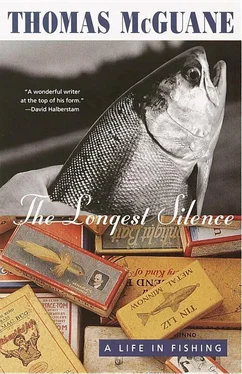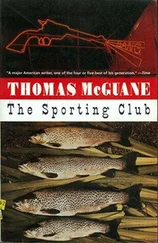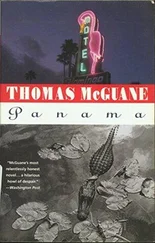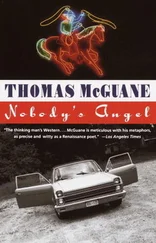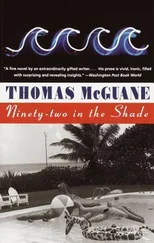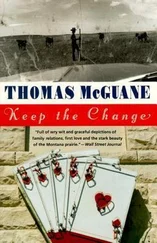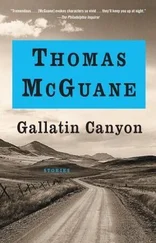It feels like a tarpon day. Spring tides will give us a good push of water. The wind has swung almost into the full south and it’s already hot. Up the keys the yellow mosquito plane will be skimming in over the mangroves, its cloud of spray hanging and settling in the windless air.
There are sponges drying on the balconies of some of the old wooden houses, and as if you might forget that the town is at sea, gulls and frigate birds soar high overhead. Next to Key West Oxygen Service, in an ugly asphalt parking lot that rivals the La Brea tar pits in midsummer, a bonefish skiff sits high on its trailer, bridging the imagination from the immediate downtown of Key West — both an outrageous honky-tonk and a memento of another century — to its gauzy, impossibly complex backcountry surrounds. When you’re at the drivein movie in Key West, watching adult fare with all the other sweating neckers, the column of light from the projectionist’s booth is feverish with tropical insects blurring the breasts and buttocks on their way to the screen. At low tide you smell the mangroves and exposed tidal flats nearby, and you’re within a mile of sharks that could eat you like a jujube. Once the movie is over and you’ve hung the speaker back on its post and are driving home, palmetto bugs and land crabs pop under the tires.
This morning, when we get to Garrison Bight, we turn off before the causeway and pull into the dry shed where my boat is stored. Across the bight at the ramp, a skiff is being launched behind a station wagon. I take out the binoculars and look. It’s a Hewes guide boat. I see the chairs, the enormous engine, the push pole, the Teleflex steering up in the forward corner, and over me and my companion, Guy de la Valdene, comes that specific competitive tension you feel when another skiff is working the same country. If Saint Francis showed up with a guide boat behind his car, we would rather he stayed home. Every shallow-water fisherman down here is cordial on land, monstrous at sea.
It’s not Stu Apte; his skiff has a center console. It’s not Bill Curtis; his is yellow, and furthermore he fishes Key West mainly on permit charters. Woody Sexton is in Loggerhead today. Jim Brewer fishes out of a Fibercraft and this is a Hewes. Bob Montgomery has an offshore charter. Cal Cochran? He’s supposed to have plenty of fish in his backyard at Marathon. Same with Steve Huff. Page Brown fishes out of a Mako and he would have told us if he was fishing Key West. It would be nice to know who it is so we could avoid running the same pattern. Possibly one of the sports from an angling club, chasing points, mounts, and records.
Richard, the manager of the boatyard, comes out and says, “Morning, Mister Tom,” with that special look of philosophical resignation that is the hallmark of the Key West Conch. He climbs up on the forklift and heads into the shed for the skiff. I had it built right here at the yard only last winter, and the first rip of boat fever has not passed off. I love to watch the skiff come out on the fork so I can see the long, precise chine running from stem to bait wells. When the boat emerges, Guy says, “Yes, I know it’s beautiful, but please don’t say it again.”
“I know, but—”
“Don’t say it.”
Richard rolls the forklift forward onto the concrete dock and lowers the boat into the slick water. To the untutored eye, nothing about the skiff is exceptional: bare nonfouling utility has been taken as far as the mind could create demands for the boat-builder.
The glass hull, brought down bare from the mainland, is white, low, and spare. From the side it looks like a simple linear gesture, the blade of a scimitar or an arrow. It is seventeen-feet, two-inches long, not counting the integral bait wells. The boat was built up from this bare hull with three-quarter-inch marine plywood, the arm-and-a-leg variety. From above, the skiff appears as a succession of bare surfaces over which a fly line can blow without snagging; the forward casting deck is continuous with the broad, flat gunwales. The aft deck is set slightly below the gunwales and, like the casting deck, overhangs the bulkheads by half an inch. Set into the aft deck are the lids of two dry-storage boxes, a battery box, and an insulated icebox. All topside surfaces are blue-gray.
The steering is forward and starboard, with the wheel set horizontal to the deck. Donald Duck’s picture is in the hub; a pacifier hangs from the ignition. The throttle and gearshift controls are in a single lever, and there is a tachometer with which I pretend to monitor my engine’s performance. I monitored my previous engine’s performance, noticing not a thing right up until the idiot light turned on, a plug blew out of a cylinder and the whole thing froze like a tractor in quicksand. There is a toggle on the dash for the power tilt, the 125 Evinrude on the transom being too heavy for hand-tilting as frequently as flats fishing requires.
Guy is at the gas dock, filling the stainless forty-gallon tank under the casting deck. I get a block of ice and put it in the cooler with our lunch and twelve soft drinks. The rods go under the port gunwale, rain gear under the seat. The tackle box goes aboard with a couple dozen of Guy’s shock tippets rolled like surgeon’s suturing materials. And now we’re ready, suddenly feeling the anticipation that is the result of the watching weather, reading the Coast and Geodetic Survey tide book, and listening to all the baloney and general hearsay from guides and other anglers about just where it is the tarpon might be.
Along the starboard gunwale, flexed tight against it, is the big kill gaff with its seven-foot hardwood handle, never to be used on a fish less than a world record, though Guy and I agree that the goal is to train oneself to release that fish, too. But at this early stage of development the gaff still goes along. Someday, when we have grown enough in the fishing, the gaff will be nailed up over my desk, with the stainless-steel gaff head that I wrapped and epoxied myself, a rather handsome old souvenir of barbaric times. On top of the port gunwale, resting in two teak chocks and secured with aviation shock cord, is a seventeen-foot push pole.
Choked and started, the engine idles on the transom; the boat trembles and laps gently against the dock. Guy slips the lines and pushes us away from the dock and I put it in forward, easing us out past the crawfishing boats and two or three sponge boats with tongs laid across the seats, then out into the basin in the low angle of light. Idling along, the boat rides low in the water with radically little freeboard. This is a skiff that will run forty miles an hour in less than a foot of water; offshore, it would be as reassuring as a waterlogged mahogany plank. Its design, derived from numerous other boats but primarily those built by Eddie Geddiman, is a pure, indigenous product of the fishing conditions of the Florida Keys. A fast, shallow-water boat.
We pass under the Garrison Causeway as morning work traffic is beginning to rush overhead. We can smell its exhaust with the same emotions with which we perceive the hamburger stands over by the charter-boat docks. Once on the other side, there’s that damned guide boat we saw being launched, up on a plane now and way out at the front edge of a fan of wake. I hear the honking overhead and then a siren as a policeman runs down some sorry gob in a GTO. The brilliantly painted Cuban fishing boats are off to our left, gaudy as Arab smacks; behind them is the institutional slab of the navy bachelor officer quarters, built with the military’s usual flair for grace in design.
By now the guide boat has upped and gone. We don’t know where he could be and are just hoping that our two skiffs don’t go wandering over the ocean making the same stops, tripping over each other as in some mis-timed, syncopated dance step.
Читать дальше
